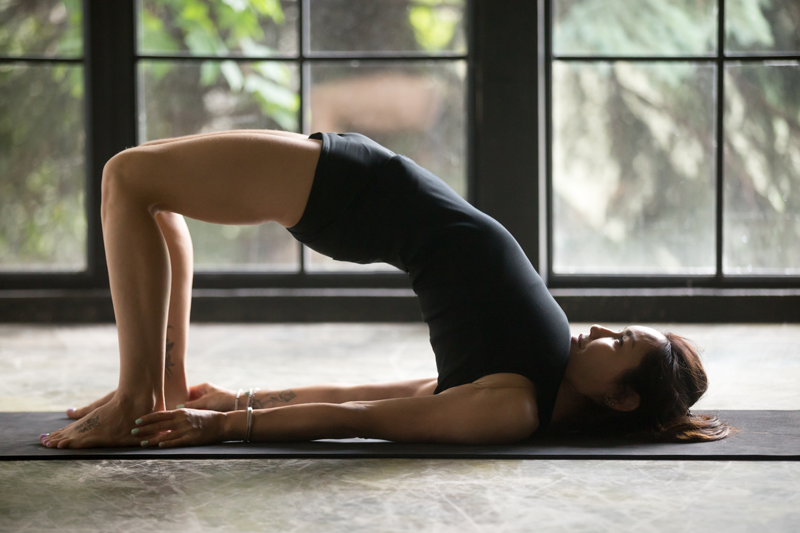Irritable bowel syndrome and other digestive issues are becoming more common by the day, and for some individuals, modern medicine just isn’t doing the trick. Today, many people are seeking the help of alternative therapies to relieve their symptoms – one of the most popular being yoga. It’s no secret that yoga can greatly benefit our health, but can it help to reduce bloating? To answer simply, yes it can. In this article, we explore how the holistic treatment can benefit digestion, and discuss exactly how people are reducing bloating with yoga.
How Can Yoga Reduce Bloating?
There no question that digestive issues are exacerbated by stress. Whether you’re suffering from irritable bowel syndrome, stomach ulcers, or you’re just feeling a little bunged up, practicing yoga regularly can help to relieve unpleasant symptoms – bloating included. Like any exercise, getting your body moving through yoga can ease constipation. Certain postures can help food and waste products to transport quicker through your system, providing gentle relief from the discomfort associated with constipation and bloating.
Practicing yoga for just 20 minutes each morning can improve gastrointestinal circulation for the rest of the day. Not only will this decrease gas, but it will also help the body to absorb food better, allowing individuals to get a higher nutritional value from their meals. Most yoga postures incorporate rhythmic breathing; this relaxes both the body and mind, allowing you to go about the rest of your day free of stress. Simply, less stress means a happier digestive system, so getting your yoga pants on each morning can do the world of good for bloating.
Studies have shown that the benefits of yoga on the digestive system or similar to that of a body massage. Stretching and moving the intestines will encourage food and waste to move quicker, providing long-term relief of bloating and associated symptoms.
Tips Before You Begin
Below, we explore a selection of postures great for reducing bloating. First, take note of some tips and tricks to get maximum benefit from each of the poses.
- Practice in the Morning: practicing the postures in the morning will allow your digestive system to reap the benefits for the rest of the day. Additionally, exercising in the morning gets it over and done with, leaving you free to focus on anything else you have planned.
- Perform on an Empty Stomach: These postures are best performed on an empty stomach – another great reason to get started as soon as you wake up. Once you’re finished, take time to relax and enjoy and healthy breakfast.
- Drink a Glass of Water: If possible, drink a glass of water before you start – especially if you’re practicing first thing in the morning. Sipping on a glass of water before beginning will ensure your body is hydrated and raring to go.
- Wait 15 Minutes Before Showering: Once you’re finished, try to wait at least 15 minutes before having a bath or shower. This will allow the body time to calm down.
Poses to Reduce Bloating
Wind Relieving Pose
Unsurprisingly, Wind Relieving Pose is great for reducing bloating. To begin, rest your back on your yoga mat. Once comfortable, gently draw your knees into your chest and slowly rock from side to side to mas-sage your lower back. After a couple of seconds, extend your left leg while keeping your right leg tucked into your chest. Move your right thigh to rest gently on the ground. You are in Wind Relieving Pose. Hold the posture for 8-10 breaths before switching sides.
Twisting Childs Pose
With benefits including increased blood flow and circulation, twists are great for digestion. For best results, try Twisting Childs Pose with a couple of yoga blocks underneath your hands. To begin, kneel on your yoga mat resting your hands on the floor in front of you. Sit back on your heels, reaching your arms forward to lengthen both sides of your waist. Next, move both hands toward your left knee. If you’ve got some blocks to hand, place one underneath your head to keep your neck aligned. You are now in Twisting Childs Pose. Holds the pose for 8-10 breaths before switching sides.
Burrito Pose
To practice Burrito Pose, you’ll need to have a blanket or towel to hand. To make the posture cozier, you can use a pillow, too. To start, roll your blanket into the shape of a burrito or sausage, ensuring it is roughly 5 inches in diameter. Next, gently lay down on your stomach, placing the rolled blanket directly underneath your belly button. To keep the spine aligned, place your pillow or a block underneath your forehead. You are in Burrito Pose. Hold the posture for a few minutes, allowing the weight of your body to melt into the blanket.
Cat/Cow Pose
Helping to stretch out the abdomen, Cat/Cow Pose is great to finish your workout with. Begin the posture on all fours, keeping your hands directly underneath your shoulders and your knees underneath your hips. Next, slowly dome your back, drawing your belly button toward the ceiling. You are in Cat Pose. After a couple of seconds bring your belly button down towards the mat, bending your back in the opposite direction to before. You are in Cow Pose. Continue switching between the 2 for a couple of minutes, remember to breathe properly throughout.
In Summary
Whether you’re an unfortunate sufferer of irritable bowel syndrome or you tend to feel a little bloated after eating certain foods, practicing these postures for just 20 each morning can greatly reduce bloating and other forms of digestive discomfort. To get the most from these postures, it’s essential to wear flexible yoga clothes. For those looking for a lightweight top, we recommend the Ana Heart, Karl Asymmetric T-Shirt.

